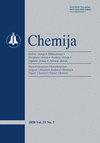用于表征与肥胖相关的生物组织特定特征的分析方法:综述
IF 0.4
4区 化学
Q4 CHEMISTRY, MULTIDISCIPLINARY
引用次数: 0
摘要
肥胖已成为一种全球流行病,导致许多常见疾病的发展,如2型糖尿病、代谢综合征和心血管疾病,甚至增加了几种癌症的风险。肥胖患者的脂肪组织是由脂肪组织巨噬细胞、前体细胞和肥厚脂肪细胞以及其他主要产生促炎细胞因子的免疫细胞组成的组织微环境,用于慢性、低度炎症。在这项研究中,几种分析技术,如气相色谱和液相色谱,傅里叶变换红外(FTIR)和拉曼光谱,核磁共振(NMR)光谱,扫描电子显微镜(SEM)和元素分析,被讨论作为主要工具用于脂肪组织样品的表征。重点是所获得的结果提供了有关人体脂肪组织层的化学和结构组成的信息,以及主要的微观结构特征与肥胖之间的关系。结果表明,这些方法是研究人体脂肪组织的某些特殊特征、识别脂肪组织的化学成分和结构特征所不可缺少的工具。此外,总结的结果让我们得出结论,脂肪组织的这种特征是可能预测不同疾病症状出现的必要步骤。本文章由计算机程序翻译,如有差异,请以英文原文为准。
Analytical methods used for the characterisation of specific features of biological tissues related with obesity: A review
Obesity has become a global pandemic, leading to the development of many common disorders, such as type 2 diabetes, metabolic syndrome and cardiovascular diseases, and even increases the risk of several cancers. The adipose tissue of obese patients was characterised as a tissue microenvironment composed of adipose tissue macrophages, precursor and hypertrophic adipocytes, and other immune cells that predominantly produce pro-inflammatory cytokines for chronic, low-grade inflammation. In this study, several analytical techniques, such as gas and liquid chromatography, Fourier transform infrared (FTIR) and Raman spectroscopies, nuclear magnetic resonance (NMR) spectroscopy, scanning electron microscopy (SEM) and elemental analysis, were discussed as the main tools used for the characterisation of adipose tissue samples. The emphasis was focused on the relation between the obtained results which provide information about the chemical and structural composition of adipose tissue layers in the human body, as well as main microstructural features and obesity. It was demonstrated that these methods are indispensable tools in order to investigate some special features of human adipose tissue, identifying chemical composition and structural features. Moreover, the summarised results let us to conclude that such characterisation of adipose tissue is an essential step for the possible prediction of the appearance of symptoms of different diseases.
求助全文
通过发布文献求助,成功后即可免费获取论文全文。
去求助
来源期刊

Chemija
化学-化学综合
CiteScore
1.30
自引率
16.70%
发文量
14
审稿时长
>12 weeks
期刊介绍:
Chemija publishes original research articles and reviews from all branches of modern chemistry, including physical, inorganic, analytical, organic, polymer chemistry, electrochemistry, and multidisciplinary approaches.
 求助内容:
求助内容: 应助结果提醒方式:
应助结果提醒方式:


